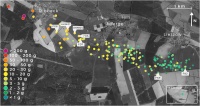(Unless otherwise stated, the copyright of the materials included belong to Jan Woreczko & Wadi.)
Szablon:Bischoff (2024)
Z Wiki.Meteoritica.pl
Bischoff Addi, Patzek Markus, Barrat Jean-Alix, Berndt Jasper, Busemann Henner, Degering Detlev, Di Rocco Tommaso, Ek Mattias, Harries Dennis, Godinho Jose R.A., Heinlein Dieter, Kriele Armin, Krietsch Daniela, Maden Colin, Marchhart Oscar, Marshal Rachael M., Martschini Martin, Merchel Silke, Möller Andreas, Pack Andreas, Raab Herbert, Reitze Maximilian P., Rendtel Ina, Rüfenacht Miriam, Sachs Oliver, Schönbächler Maria, Schuppisser Anja, Weber Iris, Wieser Alexander, Wimmer Karl, (2024), Cosmic pears from the Havelland (Germany): Ribbeck, the twelfth recorded aubrite fall in history, Meteoritics & Planetary Science, vol. 59(10), 2024, s. 2660-2694 (abstrakt). Plik doi.
Abstract: In 1889 the German poet and novelist Theodor Fontane wrote the popular literary ballad “Herr von Ribbeck auf Ribbeck im Havelland.” The Squire von Ribbeck is described as a gentle and generous person, who often gives away pears from his pear trees to children passing by and continued donating pears after his death. Now, 135 years later the rock called Ribbeck is giving us insight into processes that happened 4.5 billion years ago. The meteorite Ribbeck (official find location: 52°37′15″N, 12°45′40″E) fell January 21, 2024, and has been classified as a brecciated aubrite. This meteoroid actually entered the Earth's atmosphere at 00:32:38 UTC over Brandenburg, west of Berlin, and the corresponding fireball was recorded by professional all sky and video cameras. More than 200 pieces (two proved by radionuclide analysis to belong to this fresh fall) were recovered totaling about 1.8 kg. Long-lived radionuclide and noble gas data are consistent with long cosmic ray exposure (55–62 Ma) and a preatmospheric radius of Ribbeck between 20 and 30 cm. The heavily brecciated aubrite consists of major (76±3 vol%) coarse-grained FeO-free enstatite (En99.1Fs<0.04Wo0.9), with a significant abundance (15.0±2.5 vol%) of albitic plagioclase (Ab95.3An2.0Or2.7), minor forsterite (5.5±1.5 vol%; Fo99.9) and 3.5±1.0 vol% of opaque phases (mainly sulfides and metals) with traces of nearly FeO-free diopside (En53.2Wo46.8) and K-feldspar (Ab4.6Or95.4). The rock has a shock degree of S3 (U-S3), and terrestrial weathering has affected metals and sulfides, resulting in the brownish appearance of rock pieces and the partial destruction of certain sulfides already within days after the fall. The bulk chemical data confirm the feldspar-bearing aubritic composition. Ribbeck is closely related to the aubrite Bishopville[1]. Ribbeck does not contain solar wind implanted gases and is a fragmental breccia. Concerning the Ti- and O-isotope compositions, the data are similar to those of other aubrites. They are also similar to E chondrites and fall close to the data point for the bulk silicate Earth (BSE). Before the Ribbeck meteoroid entered Earth's atmosphere, it was observed in space as asteroid 2024 BX1. The aphelion distance of 2024 BX1's orbit lies in the innermost region of the asteroid belt, which is populated by the Hungaria family of minor planets characterized by their E/X-type taxonomy and considered as the likely source of aubrites. The spectral comparison of an average large-scale emission spectrum of Mercury converted into reflectance and of the Ribbeck meteorite spectrum does not show any meaningful similarities.
Fig. 3. The strewnfield with the Ribbeck samples registered by our team. Source of base map: Google Earth. The studied samples are marked by arrows. |
Fig. 16. Cumulative mass-number distribution of individual Ribbeck meteorites and meteorite falls reported in the literature. The linear fit in log–log space (heavy dashed line; R2 = 99.3) comprises masses from the largest recovered meteorite down to masses of 2.5 g (vertical dashed line). On extending the fit below 2.5 g, R2 decreases due to a deficit of recovered meteorites relative to the extrapolated power law. For other meteorite falls across different types, the deviation from the power law behavior is much more pronounced (Sutter's Mill[2] C-type chondrite, Jenniskens et al., 2012); Almahata Sitta[3] polymict chondritic/ureilitic breccia, Shaddad et al. (2010), Bischoff, Bannemann, et al. (2022); Košice ordinary chondrite, Gritsevich et al. (2014); Sariçiçek[4] howardite, Unsalan et al. (2019). |

